A sales pitch is many things – a script, a performance, a conversation, even a research piece. That means a sales rep wears many hats. She’s a writer, a public speaker, a detective, and a researcher.
But there are some ingredients that do not belong in the perfect sales pitch recipe because the way people buy has evolved. And yet reps continue to dole them out, often without realizing the damage they may cause.
A pitch is not a speech you’ve committed to memory. You shouldn't break into nervous sweats and shake in your boots while delivering it. Every sales pitch for every meeting is, instead, a cocktail of winning combinations.
With growing competition and the consequent information overload, you have to rethink your approach to creating a sales pitch. In this blog, we discuss how.

What Is a Sales Pitch?
There is little consensus on the definition of a sales pitch, a quick sweep of the first few pages on Google search shows.
Some conflate it with an elevator pitch. Some argue it’s a shortened version of a sales presentation. Others claim it’s anything a sales rep does to engage a prospect – from cold calls to casual conversations.
Sales pitch is a speech that you have to deliver (perform) to persuade your prospects to buy something.
Two things jump out –
- One, the goal of a sales pitch is to convince customers.
- Two, the act of delivering a sales pitch is a performance.
Peter Coughter in The Art of the Pitch argues that “everything is a presentation”. You’re being judged when you grab a couple of cold ones with your colleagues, meet your partner’s parents, or have a friendly chat with your boss. You’re always performing or presenting without even realizing it.
Sales pitches are similar. So, yes any interaction you have within the sales universe to talk up your product is, in fact, a sales pitch.
Sales pitches can happen anywhere - in conference rooms or elevators or over coffee, and even via Instagram.
Whether you are selling your product or finding buyers for your business, a sales pitch is a core component.
7 Reasons Why a Sales Pitch Fails
Sales reps get so carried away with focusing on delivering a good sales pitch that they often neglect to understand what makes a bad one.
Most reps have been there. Repeating redundancies and cliches, or making criminal, inexcusable blunders. And it's alright. We are learning and evolving.
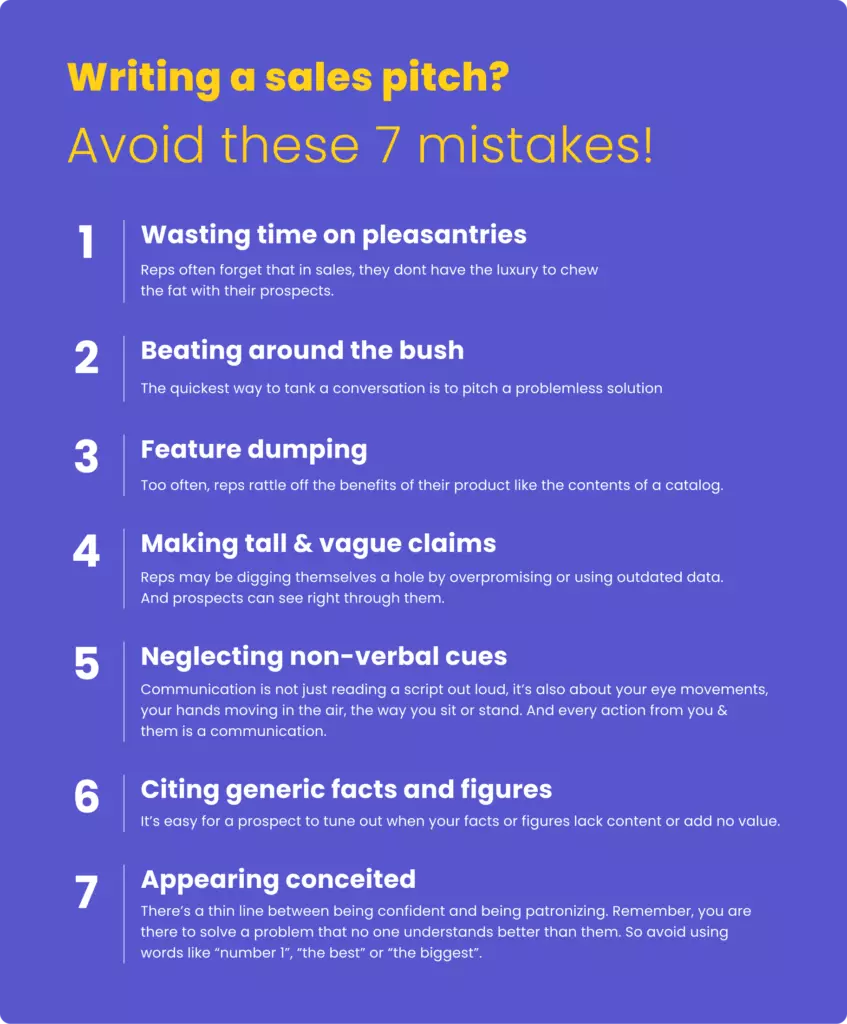
So here are a few things you should avoid like the plague when you’re crafting a sales pitch —
1. Wasting time on pleasantries:
Yes. It is the norm to open conversations with your usual how-do-you-dos and how's-it-goings. Social conduct dictates it. But, reps often forget that in sales, they don’t have the luxury to chew the fat with their prospects. You're racing against time to make your point while struggling to hold their attention.
So, saying something like this can be damaging –
“Hi, this is Joan Waters from XYZ. How are you? I trust your weekend went well…”
Should you assume what was up with them over the weekend?
Instead, think of ways to open your piece with something they care about. Nothing tells a prospect that you’re legit like acknowledging their pain points and hinting at a solution.
Consider this opener –
“Hi, this is Joan Waters from XYZ. We provide expertise in helping small online businesses like yours to scale up.”
It doesn’t waste time with pleasantries. It's a short introduction of the company. And it extends a warm touch by showing the prospect that you know who they are and what they’re struggling with.
2. Beating around the bush
The quickest way to tank a conversation is to pitch a problem-less solution. Look at it this way – you’ll never sit through a movie or finish a book that you can’t relate to. Unfortunately, reps tend to lecture about generic issues. They fail to identify individual problems, losing prospects’ attention quickly.
You should reel them in by empathizing with their problem. Then, establish your credibility by citing examples, case studies and data.
For example –
“95% of Shopify sellers fail because they lack the resources and expertise to expand. It doesn’t help that thousands of businesses join the platform each year, making competition for businesses like yours more cutthroat.”
This way, you can understand their pain points, walk them through solutions open to them, and offer a tailored solution.
3. Feature dumping
All too often, reps rattle off the benefits of their product like the contents of a catalog. Such a features dump achieves nothing – 'why should I care about your 3 fantastic, intuitive features if it doesn't solve my problem?'
Instead, do your research beforehand and ask questions to understand the prospect’s pain points. Then, take a problem-solution approach centered around your product.
This is where you plug your value proposition – the outcome a prospect can expect from using your product, or the business value derived from it.
According to sales strategist Jill Konrath, a value proposition is quantifiable. It promises to improve a certain metric. It should also shake up the prospect’s status quo by improving their current situation in some way. The best value propositions also reference how you helped other clients in similar situations.
This is how you can lay out your value proposition –
“Our team is made up of seasoned advertisers and marketers, and some of the best minds in the business. They have helped drive conversion rates by 25% for businesses similar in valuation to yours.”
4. Making tall & vague claims
Reps often dig themselves a hole by overpromising or using outdated data. And prospects can see through them. They will counter-question such vague pronouncements and put you in a rough spot.
This is not to say that reps shouldn’t draw from prior experience or back their spiel with data points. They should instead tap into social proof.
Establishing social proof is like giving a book or movie recommendation. Tell the prospect how your product helped a previous client solve a similar problem.
Here’s an example –
“Our clients found that working with us was like driving in cruise control. Constrained by lack of resources, they could trust us to take care of the nitty-gritty while being involved in the capacity of supervisors themselves.”
5. Neglecting non-verbal cues
Reps often find themselves so preoccupied with what to say that they neglect how to say it. This is important. Hear us out.
Communication is not just reading a script out loud, or saying things. It’s also about your eye twitches, your hands flapping in the air, the way you sit or stand–and other non-verbal cues.
There is a rule for how we communicate. The 7-38-55 Rule, developed by psychology professor Albert Mehrabian at the University of California. So when we're talking, only 7 percent of what we mean is put into spoken words. 38 percent is conveyed through tone of voice and a whopping 55 percent through body language.
Here are some non-verbal cues you can include in your in-person sales presentation –
- Have proper posture
- Practice good manners
- Use voice inflection to stress your point
- Create eye-contact
- Practice a firm handshake
- Face your prospect as you speak
- Nod as you listen
- Dress well
Now that’s just half the job done. You should also be sensitive to the non-verbal reactions of the prospects. Facial expressions like pursed lips and narrowed eyes could signal concern about your presentation.
Meanwhile, smiling and nodding mean they’re engaged and interested. Switch up your tone or pace when you notice them on their phones, or not ask questions when you anticipated them. Needless to say, active listening is a major player in reading these signs.
6. Citing generic facts and figures
Reps often find it hard to break the habit of quoting generic facts or spitting numbers. It’s easy for a prospect to tune out when your facts and figures lack context or add no value.
You can never go wrong with a well-timed statistic or a strategically dropped nugget of information during a pitch. But practice using them, only to support the argument you’re trying to make.
Start your presentation with an irresistible hook. Include vivid details in your deck and use visual aids to keep their attention, then support your arguments with the right peppering of facts or figures.
7. Appearing conceited
No one likes a show-off, in life or during a sales pitch. There’s a thin line between being confident and being patronizing. And reps could, sometimes, cross over to the wrong side.
Never underestimate your prospects or make them feel unintelligent. Remember, you are there to solve a problem that no one understands better than them.
A sales pitch is a game of show-and-tell. So avoid using words like “number 1”, “the best” or “the biggest”, instead prove to them that you’re number 1. Layout your solutions, testimonials, success stories, and facts. And let the prospect decide whether you’re the best option for them.
Sales Pitch Templates
Use these Sales pitch templates as a guide to craft your own sales pitch.
1. Sales pitch via email
Subject Line: Life is great, {prospect name}
Hello! Hello!
The sun is shining, the birds are chirping, and you know exactly how to solve {pain point}. Right?
If you're still working on that last one, which I know can be a real pain in the back, I'd love to offer some world-class strategies that I've shared with your friends (read: competitors).
Please feel free to book some time on my calendar if you want to sprint ahead of your friends (I know you do).
Cheers,
{Your name}💡 Related: The ultimate collection of 120+ Cold Email Templates that you can use in your sales outreach
2. Call Script
You: Hi {prospect name}, it’s {your name} with {your company name}. I noticed that {you took part in a webinar/published a blog/others} and I figured out you are looking to {reduce cost/increase efficiency in the prospect’s area of interest}. Is this an area of concern for you?
Prospect: I’ve seen a lot of people in your industry go through similar problems. Can I ask you a few questions to understand more about your situation?
You: From what we discussed, you are currently {list the challenges and pain points mentioned by the prospect} and want to {mention the result the prospect likes to achieve}.
We’ve worked with companies like X and Y in {prospect industry} who were in a similar situation and helped them {insert tangible results from clients using your product}, and I’m sure you could do the same for you.
{Prospect name}, I’ll tell you a bit more about what we can do for you. And if that makes sense to you, let’s block 20 minutes this Wednesday at 3 pm to discuss more on this. Sounds good?💡 Related: Here are the 25+ cold calling scripts to effectively handle different selling situations!
3. Elevator pitch
The elevator pitch is a little more nuanced hence it cannot be templated. It varies according to the situation. An elevator pitch can flow according to this format:
Use a question/pain point/customer success as the hook: As a fast-growing startup, you may be seeing a flurry of endless candidates - that your HR team might not be capable of handling at the moment. You have to scale your team exactly when it's needed.
Value proposition: Unlike the current HR management tools in the market that cater to enterprises, we focus on businesses like yours, those who are in early stages.
Your ask: You've grown leaps and bounds in the last two quarters, and congratulations for that! But your HR team now needs to move to the 5th gear and start accelerating. ABC tool can help you sort candidates within seconds, push candidates forward or reject them using single click actions by the hiring managers or the HRs, and ramp up hiring within a couple of days.
Now that you know how your sales pitch can vary according to your outreach channel, let's dive into some of the top sales pitches ever and learn what makes them stand out.
Sales Pitch Masterclass From 4 Sales Legends
To give an effective sales pitch, we’ve lined up four of the best examples to take cues from.
1. Mark Cuban
Back in 2000, billionaire investor Mark Cuban bought a stake in the Dallas Mavericks. But the basketball team had been voted the worst franchise in professional sports. How did Cuban turn it into one of the most successful teams in the NBA?
Let’s hear straight from the shark’s mouth.
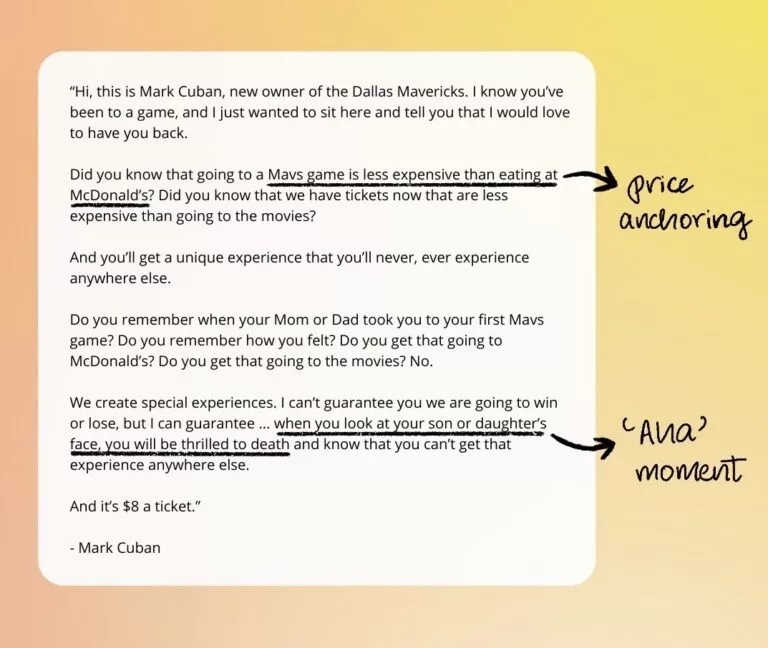
What Makes This Pitch So Special?
- Addressing pain points
Mark Cuban is very aware of who he is talking to. Yes, prospecting happens before one can even dream up a sales pitch. But this script addresses the concerns of the prospects. Like having to watch their team lose, and having to pay for tickets only to get disappointed.
The pitch promises a solution to both those things. It’s as if to say, “Remember how fun basketball games were? We know the team sucks now, but hey, the tickets are cheap. Go, relive the nostalgia at half the price.”
- Price anchoring
The comparison to a meal at McDonald’s immediately tells prospects that it’s a cheap bargain. Usually, reps would anchor the price of the product with a competitor’s. In this case, they’re offering a choice between catching the game and getting a meal at McDonald’s – both pitched as family outings – but only the former is worth it, at just $8 per ticket.
- Create an ‘aha!’ moment
Any good sales pitch builds up to a moment. It's this moment that makes or breaks your pitch. It yanks the drowsy prospect by the collar and forces them to listen up.
Here, it’s the proposition that the experience of watching the game will be unmatched. It will leave memories that will stay with your kids forever. It definitely beats going out for a greasy meal, or to the movies.
2. Don Draper
This one’s fictional. But it went down in history as one of the best sales pitches ever delivered. This striking pitch for the Photography company, Kodak, is from the TV series ‘Mad Men’. It is the perfect example of placing the value proposition front and center of the pitch instead of harping on the product.
It goes like this:
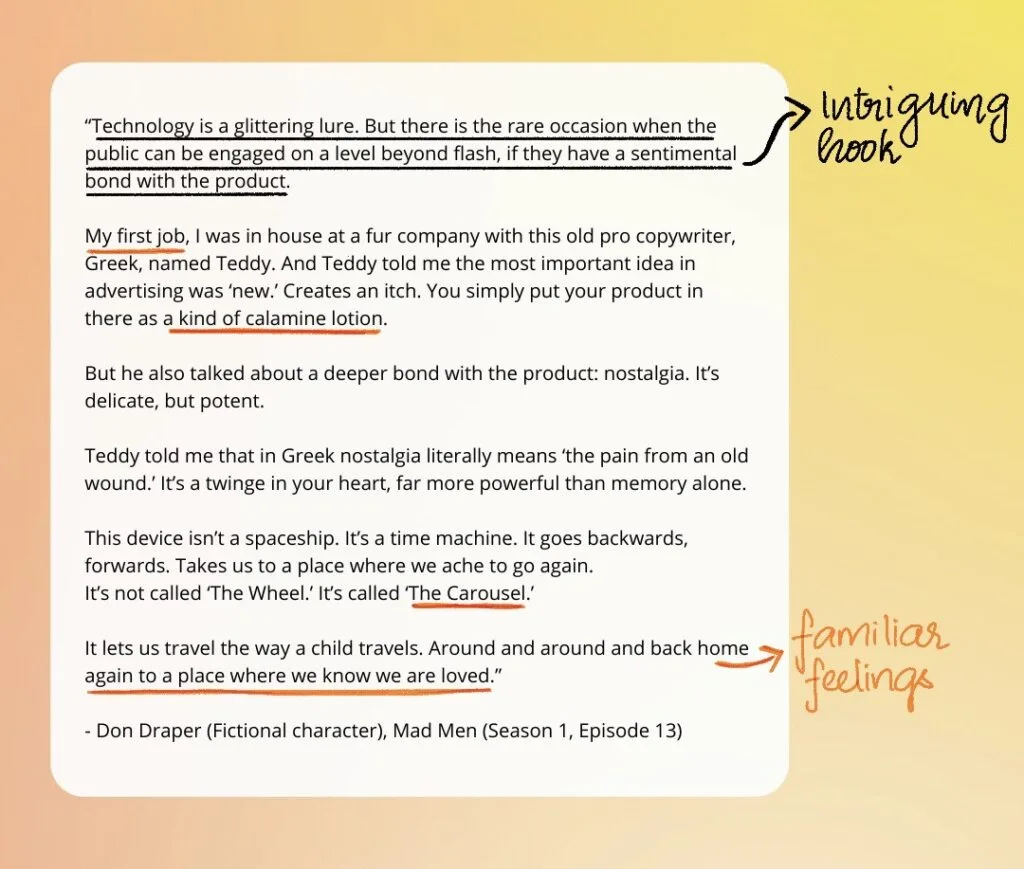
What Makes This Pitch So Special?
- Intriguing hook
This is the 1960s when gadgetry was alien to common people. The fictional character Don Draper, a.k.a. the tragic hero of the show, marries the idea of sentimentality with technology right off the bat. He proves that this tech is not something unattainable and can very well become part of home and hearth. A hook like this offers a fresh perspective and sets the tone for the rest of the presentation.
- Vivid storytelling
An evocative story follows the hook. Don Draper draws from his own experience, introduces the idea of nostalgia and seamlessly links it with the product. Prospects are far more likely to remember a story rather than hard facts and figures.
- Establishing relatability
Anyone can relate with nostalgia and childhood memories. The pitch taps into these familiar feelings to catch the attention of the prospect. The objective of a Don Draper-like sales pitch should be to find something that can strike a chord with anyone.
3. Craig Wortmann
Craig Wortmann in his popular course “Present with Panache” advocates focusing equal parts on content and presentation. Perfecting these three P’s makes for a good sales pitch in his opinion – preparation, persuasion and performance.
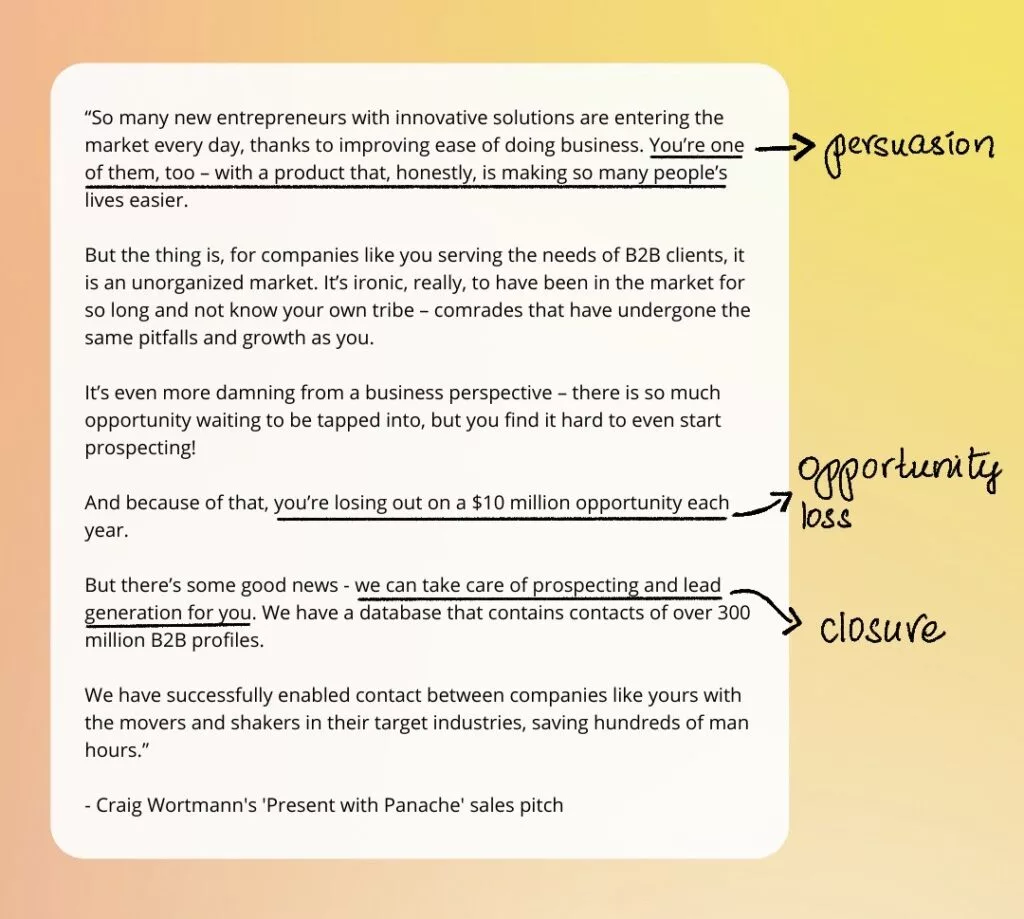
What Makes This Pitch So Special?
- Preparation
Wortmann’s ideal pitch structure opens with giving some context – a plethora of businesses in the market, in this case.
Next, it establishes the conflict that despite such a rich market opportunity, it is difficult to get in touch with these businesses.
Then, the climax – the opportunity loss.
Finally, it offers closure by giving a solution.
- Persuasion
The script touches upon the growth story of a self-made business. It also features an analogy to friendship and camaraderie – which, in Craig Wortmann’s view, are important persuasive techniques. Data points and evidence of previous success are used for a convincing end.
- Presentation
The speech should be delivered magnetically. Hone the visual, vocal and verbal aspects of the pitch with practice to emotionally engage your audience and enhance the impact of the content.
4. Robert Cialdini
Psychologist Robert Cialdini’s six principles of persuasion are often used to prime prospects by exposing them to various stimuli. Here’s an example of a pitch based on these principles followed by an analysis of how they’ve been used:
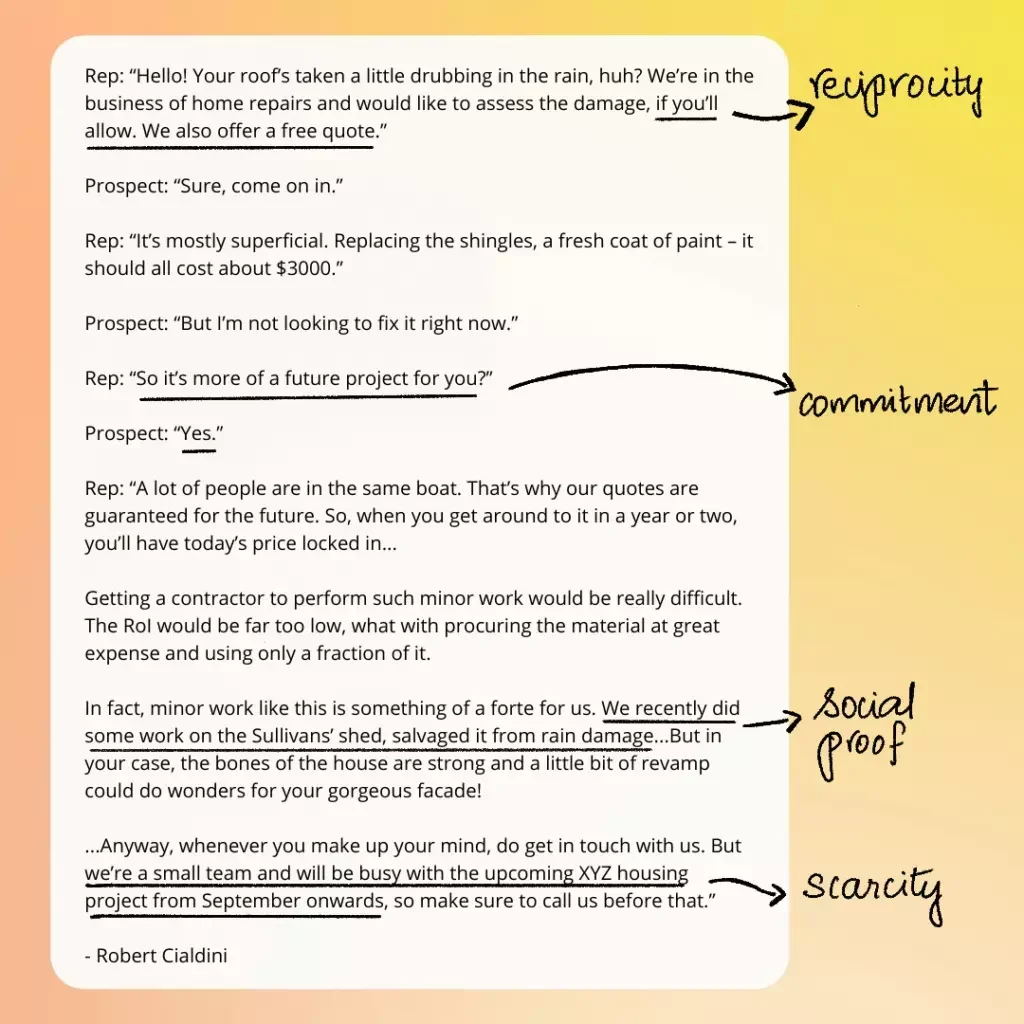
- Commitment
Once the prospect commits, they’ll feel the urge to stay consistent with their declaration. Here, they’ve committed to getting the renovation done at a future point, making it hard to ignore the seller’s offer.
- Reciprocity
Offering something – free advice about the difficulty in finding a contractor, in this case – can make the prospect feel obligated to reciprocate by making a purchase.
- Social proof
We’ve already discussed the power of social proof. People value others’ advice, recommendations and choices, making them more likely to follow suit and make the same purchase. In this example, the prospect is invited to check out the Sullivans’ shed for reference.
- Authority
Once you establish your authority in your sphere of influence, it can be hard for people to decline your request. The seller mentions their involvement in a big housing project, positioning themselves as experts in construction.
- Liking
According to Robert Cialdiani, likeability can influence a prospect positively. A compliment on the prospect’s home facade and construction quality could make them like the seller and tip the scales in their favor.
- Scarcity
People want things that are scarce in nature. Look at the demand for gemstones for example, they’re precious and expensive because they’re scarce. In this script, the seller creates a time scarcity so that the prospect would want their services immediately.
How Will You Write Your Sales Pitch?
An effective modern sales pitch is short, captivating, and entirely customer-focused. It is a test of your skill not only as a salesperson but also as a writer. But the best of us can slip up and make mistakes. The key is to identify common mistakes and practice not making them.
Here’s a snapshot of what to do instead–
- Establish the problem
- Map a solution to the problem
- Present your value proposition
- Bring up social proof
But if you want to add a certain oomph to your sales pitch, remember to follow these steps:
- Open like a peer
- Tell a story
- Use non-verbal cues to tell your story
- Back your value proposition with social proof
- Ask for interest instead of a meeting (If you're sending an email)

